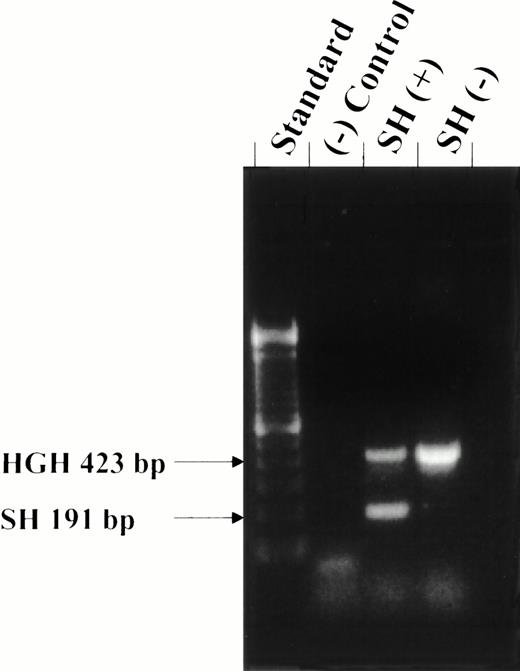To the Editor:
Human leukocyte surface receptors specific for the Fc portion of IgG play a critical role in immune function by coupling the humoral and cellular immune systems. The Fcγ receptor III (FcRIII) (CD 16), one of three Fc receptor classes, is encoded by two highly homologous genes on chromosome 1.1 FcRIIIA encodes the transmembrane receptor expressed on macrophages and natural killer cells and is not known to be polymorphic. FcRIIIB encodes the glycosylphosphatidylinositol (GPI)-linked receptor expressed on neutrophils and has three isoforms: NA1, NA2, and the recently described SH.2 SH-positive individuals possess an additional copy of the FcRIIIB gene, which may occur in tandem with NA2-FcRIIIB.3 The nucleotide sequence of the NA1 and NA2 genes both predict a protein containing 233 amino acid residues; however, the two alleles differ by five base substitutions (nts 141, 147, 227, 277, and 349) within exon 3, which predict amino acid changes at positions 36, 65, 82, and 106 of the translated peptide.4 SH differs from NA2 by only one base substitution (nt 266, C → A); this substitution predicts an amino acid change (Ala → Asp) at position 60.2
The NA antigens, which are difficult to identify by serologic tests (ie, granulocyte immunofluorescence or agglutination), are clinically important because they are the most frequent targets of neutrophil antibodies in neonatal alloimmune neutropenia (NAN), transfusion-related acute lung injury, and chronic benign autoimmune neutropenia of infancy. An SH-positive frequency of 5% has been reported for Caucasians; however, its prevalence in other racial groups is unknown.2,3 Because alloimmunization to SH has been reported to cause NAN, its distribution in other racial groups is important.2,5 Therefore, individuals (n = 799) of African American, Asian Indian, Caucasian, Hispanic, Korean, and Native American descent were SH genotyped by allele-specific polymerase chain reaction (AS-PCR; Fig 1) essentially as described by Bux et al, and gene frequencies were established (Table1).2
SH typing by ASPCR. Twenty-five μL of each reaction was electrophoretically analyzed on a 2% ethidium bromide stained agarose gel. Lane 1, size standard; lane 2, negative control; lane 3, SH-positive sample; and lane 4, SH-negative sample.
SH typing by ASPCR. Twenty-five μL of each reaction was electrophoretically analyzed on a 2% ethidium bromide stained agarose gel. Lane 1, size standard; lane 2, negative control; lane 3, SH-positive sample; and lane 4, SH-negative sample.
The highest SH gene frequency (22.5%) was observed in African Americans, whereas SH was not observed in 101 Koreans. NA1 and NA2 gene frequencies for African Americans, Asian Indians, Caucasians, Hispanics, Native Americans, and Asian populations have been reported by our laboratory and others.6,7 In general, NA2 is more common in African, Asian Indian, and Caucasian populations (gene frequencies of 70% to 63%, respectively) and becomes less common as one examines populations endogenous to the Americas and Asia (gene frequencies of 55% to 30%, respectively).6,7 In this study, the overall distribution of SH paralleled the NA2 frequency, being more common in Western populations than in Eastern populations. All SH-positive individuals were also NA1/NA2 genotyped; no SH-positive, NA1 homozygotes were observed. This is consistent with the proposed tandem genomic localization of NA2 and SH.3The high SH frequency in African Americans suggests that this group may be at a higher risk for alloimmunization to this antigen.


